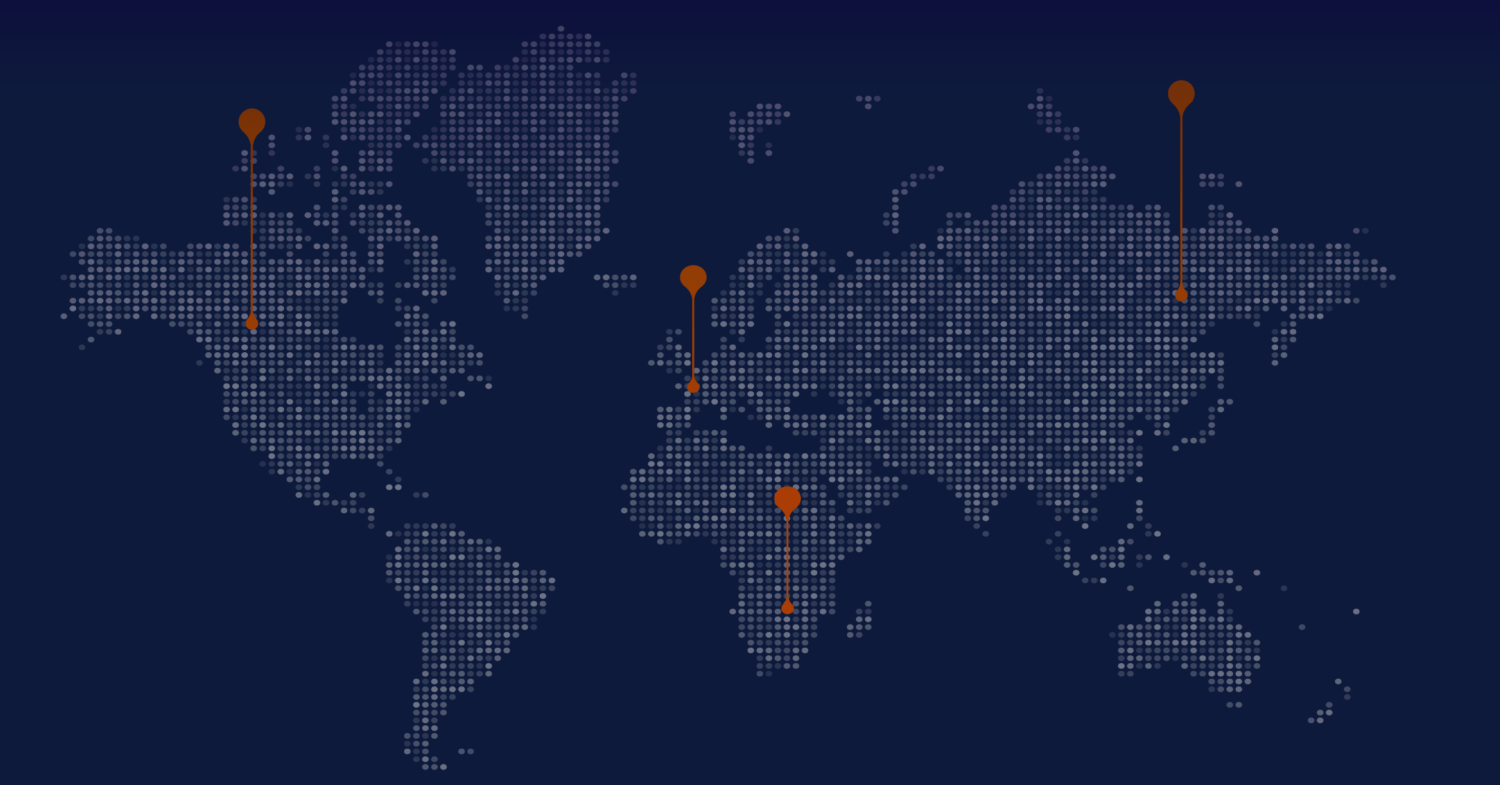This blog is a preview of our 2021 Geography of Cryptocurrency report. Sign up here to download the whole thing!
We’re excited to share with you the 2021 Chainalysis Global Crypto Adoption Index. This marks the second iteration of our efforts to measure grassroots cryptocurrency adoption around the globe, after a year of huge growth for cryptocurrency markets and increased attention for the industry.
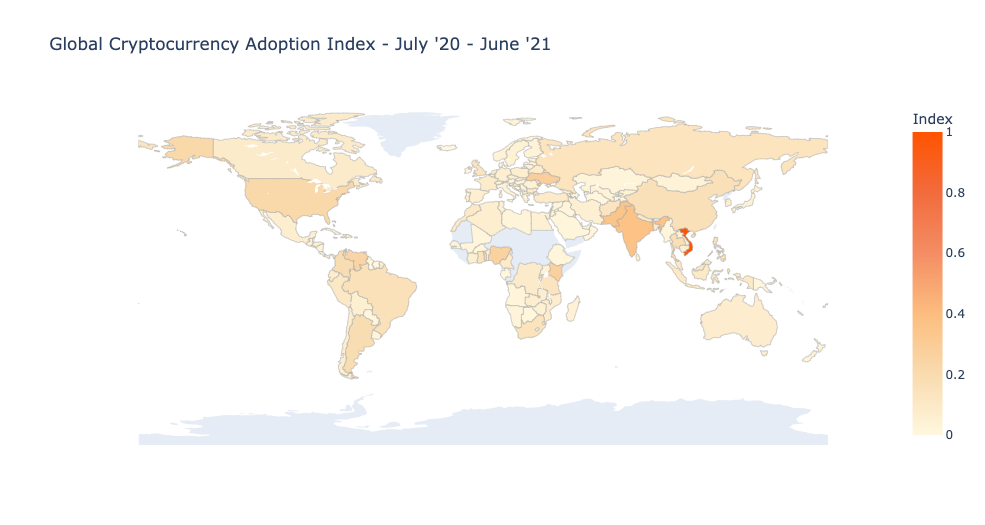
The goal of our crypto index is to provide an objective measure of which countries have the highest levels of cryptocurrency adoption. One way to do that would be to simply rank countries by transaction volume. However, that would favor only the countries with high levels of professional and institutional cryptocurrency adoption, as those market segments move the largest sums of cryptocurrency. While the professional and institutional markets are crucial, we want to highlight the countries with the greatest cryptocurrency adoption by ordinary people, and focus on use cases related to transactions and individual saving, rather than trading and speculation.
Below, we’ll explain the index’s methodology and how it’s changed compared to last year before showing you the top ranked countries for cryptocurrency adoption, as well as a few trends we found interesting.
Our methodology
The Global Crypto Adoption Index is made up of three metrics, which we’ll explain in detail below. We rank all 154 countries according to each of those three metrics, take the geometric mean of each country’s ranking in all three, and then normalize that final number on a scale of 0 to 1 to give every country a score that determines the overall rankings. The closer the country’s final score is to 1, the higher the rank.
On-chain cryptocurrency value received, weighted by purchasing power parity (PPP) per capita
The goal of this metric is to rank each country by total cryptocurrency activity, but weight the rankings to favor countries where that amount is more significant based on the wealth of the average person and value of money generally within the country.
We calculate the metric by estimating total cryptocurrency received by that country, and weighting the on-chain value based on PPP per capita, which is a measure of the country’s wealth per resident. The higher the ratio of on-chain value received to PPP per capita, the higher the ranking, meaning that if two countries had equal cryptocurrency value received, the country with the lower PPP per capita would rank ahead.
On-chain retail value transferred, weighted by PPP per capita
The goal of this metric is to measure the activity of non-professional, individual cryptocurrency users, based on how much cryptocurrency they’re transacting compared to the wealth of the average person. We approximate individuals’ cryptocurrency activity by measuring the amount of cryptocurrency moved in retail transactions, which we designate as any transaction for under $10,000 USD worth of cryptocurrency. We then rank each country according to this metric but weight it to favor countries with a lower PPP per capita.
Peer-to-peer (P2P) exchange trade volume, weighted by PPP per capita and number of internet users
P2P trade volume makes up a significant percentage of all cryptocurrency activity, especially in emerging markets. For this index, we rank countries by their P2P trade volume and weight it to favor countries with lower PPP per capita and fewer internet users, the goal being to highlight countries where more residents are putting a larger share of their overall wealth into P2P cryptocurrency transactions.
How our methodology changed in 2021
The biggest change to our methodology this year was the elimination of a fourth metric that contributed to each country’s overall ranking in 2020: Number of deposits by country weighted by number of internet users.
We initially used this as a metric to determine which countries’ residents are carrying out the most cryptocurrency transactions, as this would capture both the number of individuals using cryptocurrency and boost countries whose residents are carrying out more transactions per user. However, while cryptocurrency deposits to centralized services like exchanges show up on-chain, any transactions within those services, such as trades within an exchange, aren’t captured on-chain, and only show up in those services’ order books, which we have limited or even no access to in some cases.
This isn’t the case for DeFi though. Transactions carried out by DeFi protocol users all show up on-chain, as no centralized service ever takes custody of users’ digital assets. That skewed our rankings toward countries with comparatively more DeFi users. Therefore, after reviewing the rankings both with and without this component, we decided to eliminate it. We also decided to create a new DeFi Adoption Index, which will be available in the coming weeks.
We’re confident in our index methodology and the modifications we made to it this year, though as with any standardized measure of regional economic activity, there are limitations. Since we rely on web traffic data, usage of VPNs and other products that mask online activity would compromise our ability to accurately assign activity to a country. However, our index takes into account hundreds of millions of transactions, so VPN usage would need to be quite widespread in order to meaningfully affect the data. Experts we spoke to agreed that the index matched their perception of the cryptocurrency market, giving us more confidence in the methodology. We look forward to continuing to tweak the index methodology to ensure that our rankings accommodate evolutions in the market and get more accurate over time.
The 2021 Global Crypto Adoption Index Top 20
The table below shows the top 20 countries in our 2021 Global Crypto Adoption Index, as well as their rankings in the three component metrics that make up the overall rankings.
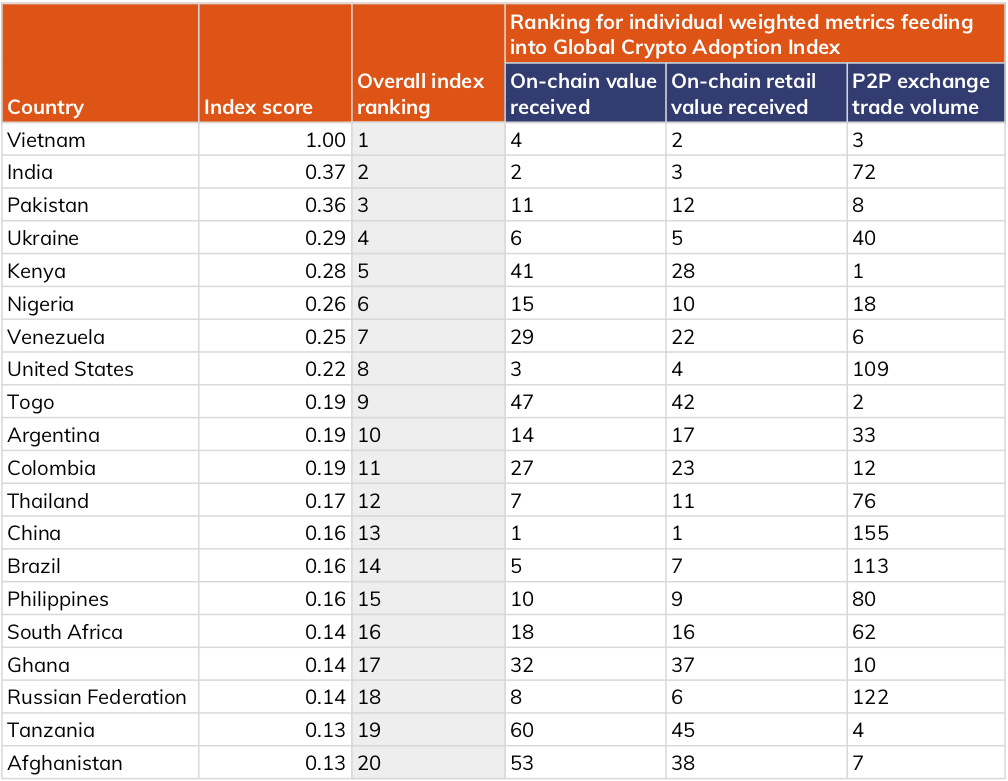
Three key trends jumped out to us as significant.
Global cryptocurrency adoption is skyrocketing
Our data shows that residents of more and more countries around the world are taking the dive into cryptocurrency or seeing existing adoption increase. In the chart below, we applied our index methodology globally by adding up all 154 countries’ index scores — made up of the three components we describe above — for each quarter from Q2 2019 to the present.
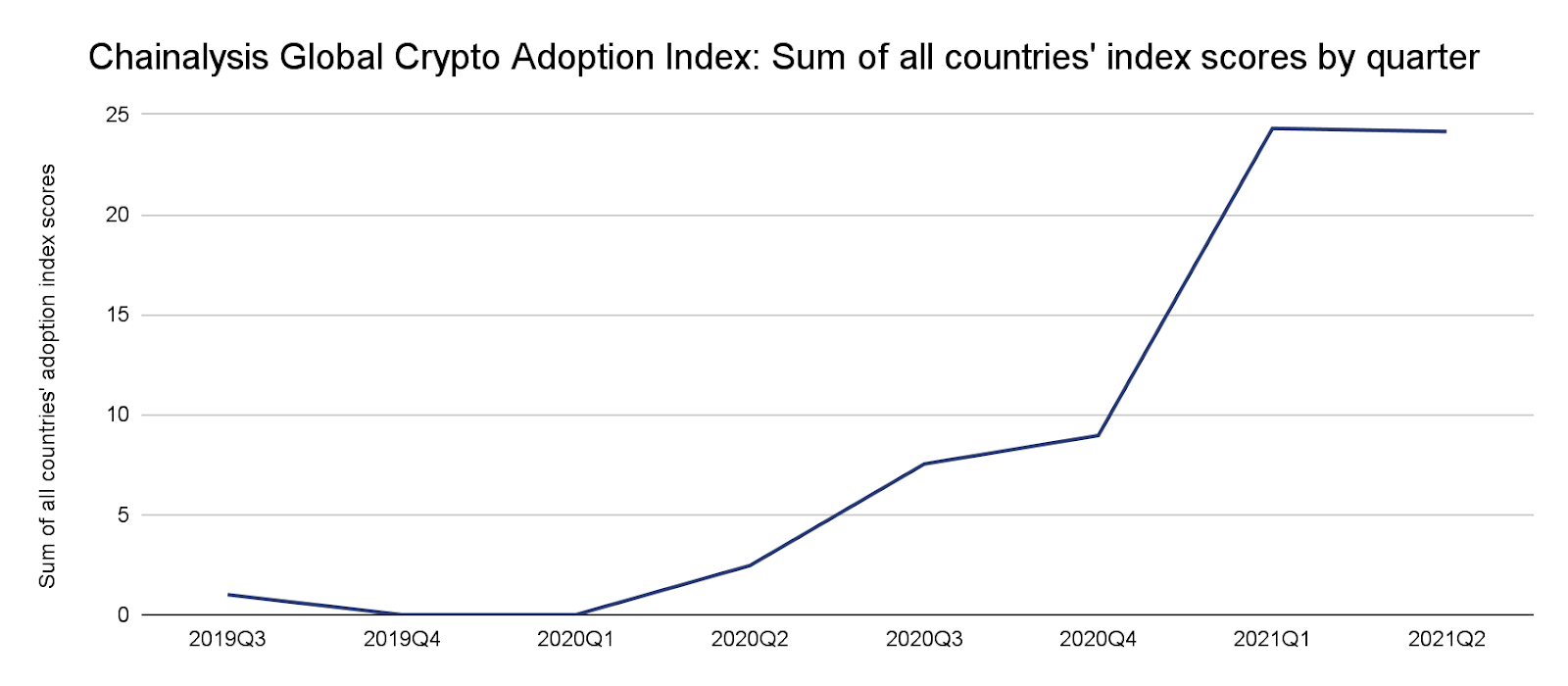
At the end of Q2 2020, following a period of little growth, total global adoption stood at 2.5 based on our summed up country index scores. At the end of Q2 2021, that total score stands at 24, suggesting that global adoption has grown by over 2300% since Q3 2019 and over 881% in the last year. Our research suggests that reasons for this increased adoption differ around the world — in emerging markets, many turn to cryptocurrency to preserve their savings in the face of currency devaluation, send and receive remittances, and carry out business transactions, while adoption in North America, Western Europe, and Eastern Asia over the last year has been powered largely by institutional investment. In a year when cryptocurrency prices rose dramatically, each region’s respective reasons to embrace the asset class seem to have proven compelling.
Adoption in emerging markets grows, powered by P2P platforms
Several countries in emerging markets, including Kenya, Nigeria, Vietnam, and Venezuela rank high on our crypto index in large part because they have huge transaction volumes on peer-to-peer (P2P) platforms when adjusted for PPP per capita and internet-using population. Our interviews with experts in these countries revealed that many residents use P2P cryptocurrency exchanges as their primary on-ramp into cryptocurrency, often because they don’t have access to centralized exchanges.
Knowing that, it’s no surprise that regions with many emergent markets account for a huge portion of web traffic to P2P services’ websites.
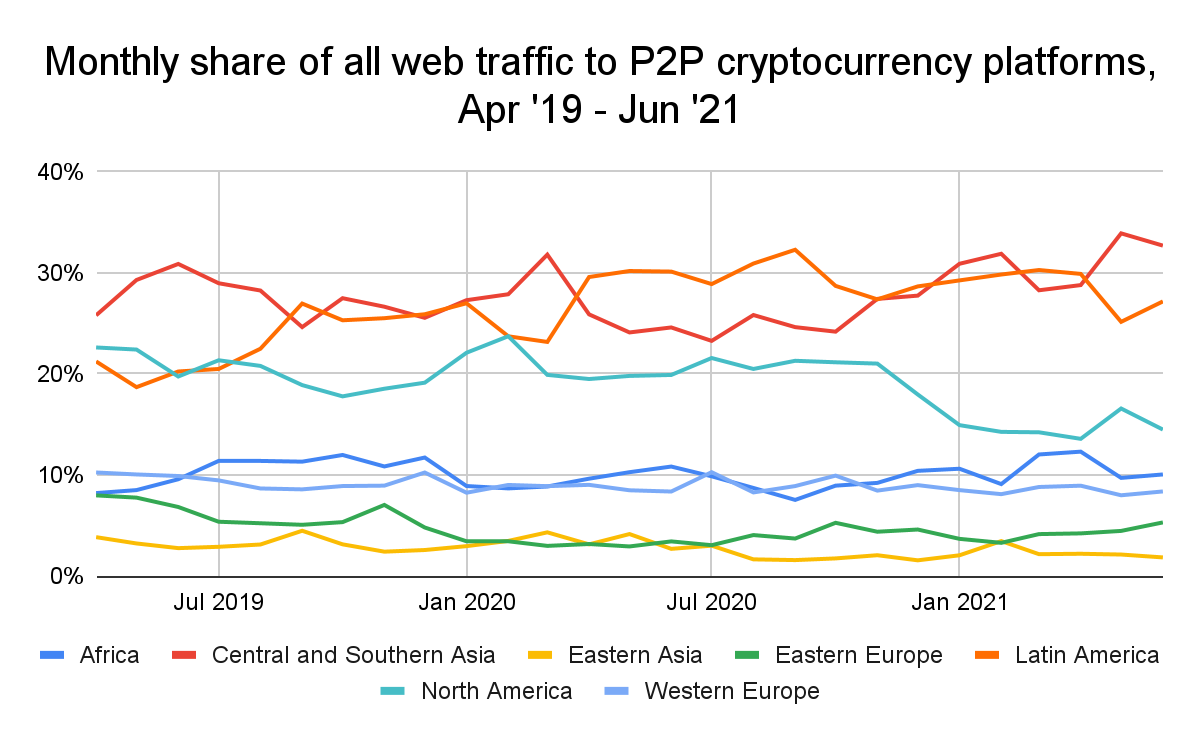
Central and Southern Asia, Latin America, and Africa send more web traffic to P2P platforms than regions whose countries tend to have larger economies, such as Western Europe and Eastern Asia.
Many emerging markets face significant currency devaluation, driving residents to buy cryptocurrency on P2P platforms in order to preserve their savings. Others in these areas use cryptocurrency to carry out international transactions, either for individual remittances or for commercial use cases, such as purchasing goods to import and sell. Many emerging markets represented here limit the amount of the national currency that residents can move out of the country. Cryptocurrencies like Bitcoin (BTC), Ethereum (ETH), and stablecoins give those residents a way to circumvent those limits to meet their financial needs.
This contributes to an interesting dynamic whereby P2P platforms have a greater share of total transaction volume made up of smaller, retail-sized payments under $10,000 worth of cryptocurrency.
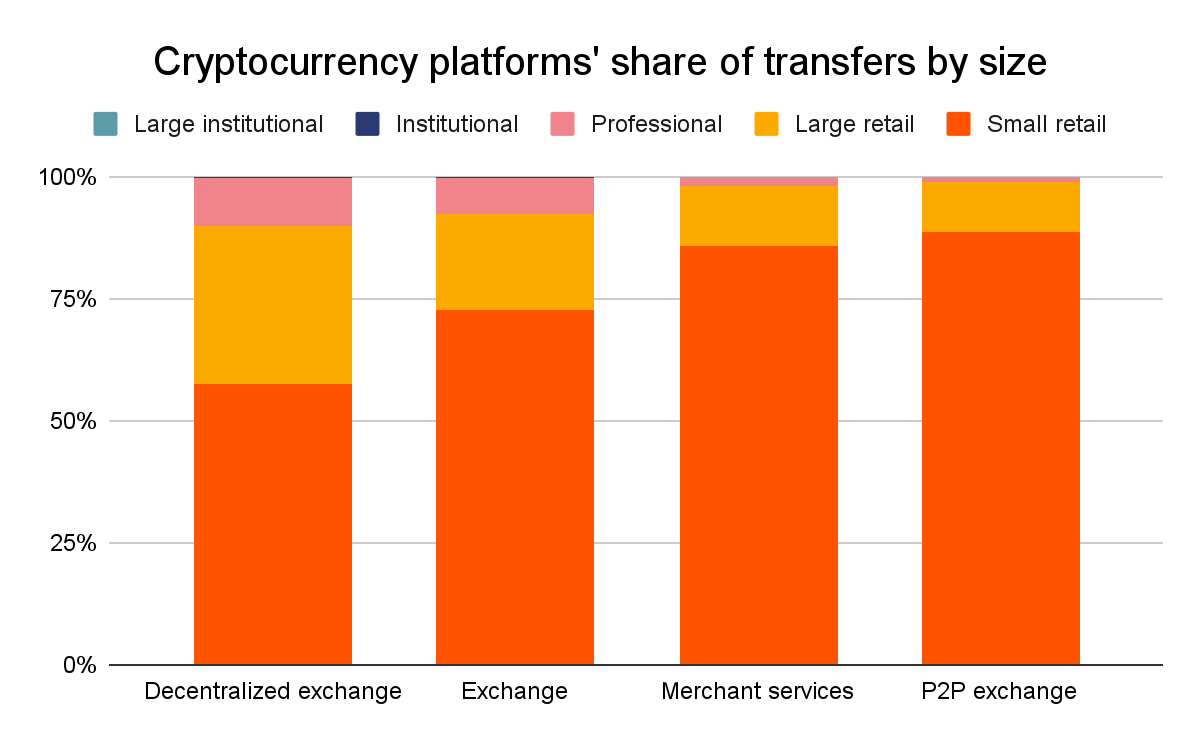
That makes sense given the use cases we described, as remittance payments and personal and commercial transactions carried out by merchants in emerging markets are likely to be smaller than transactions carried out by professional traders or institutional investors.
China and the U.S. dip in our rankings
Last year, China ranked fourth on our global adoption index while the U.S. ranked sixth. This year, the U.S. ranks eighth while China ranks 13th. The biggest reason both countries dropped is that their rankings in P2P trade volume weighted for internet-using population declined dramatically — China fell from 53rd in this component to 155th, while the U.S. fell from 16th to 109th.
Further analysis shows how far P2P volumes have fallen in the two countries compared to worldwide volumes. We show this in the index chart below, which shows relative change in P2P volumes for the U.S. and China compared to worldwide totals.
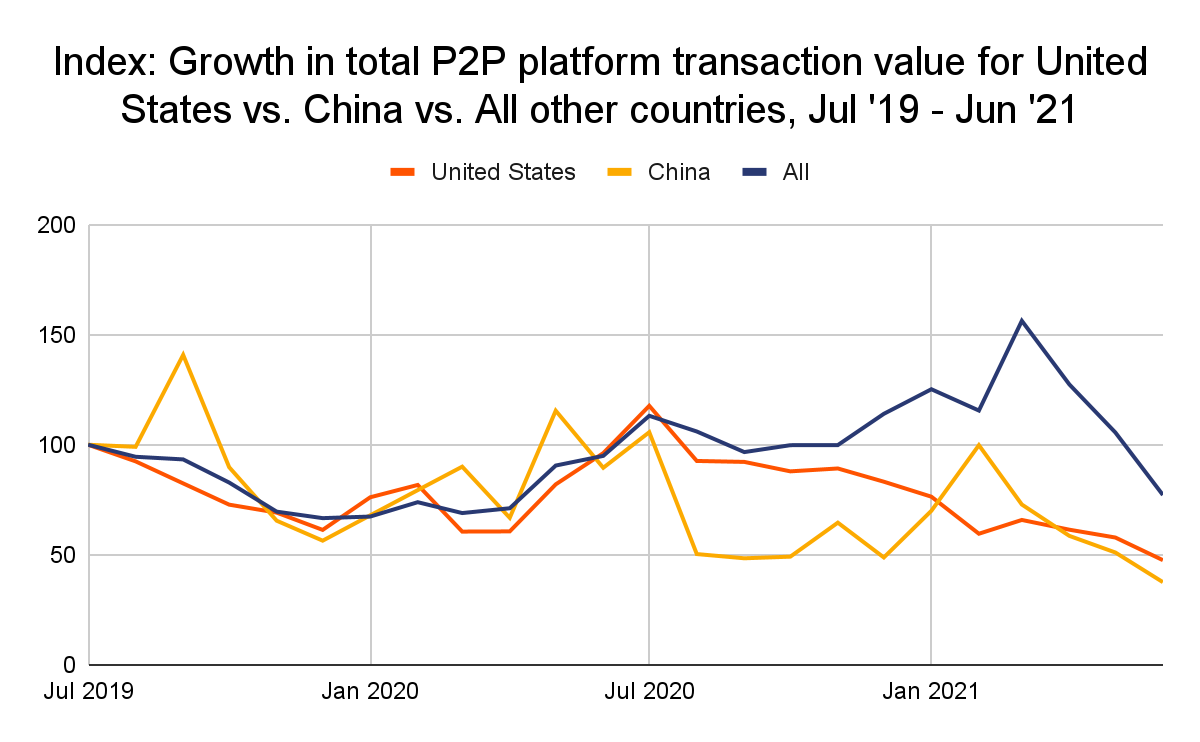
P2P transaction volume for the U.S. and China moved roughly in line with the worldwide total until they began to diverge around June 2020. At that point, the U.S. and China see their P2P transaction volume shrink as the rest of the world grows. While all three dip dramatically beginning in March 2021, the U.S. and China dip more and remain lower than worldwide totals. This activity may reflect increasing professionalization and institutionalization of cryptocurrency trading in the United States, and in China’s case may be related to ongoing government crackdowns on cryptocurrency trading.
What will drive the next wave of adoption?
Our data shows that growing transaction volume for centralized services and the explosive growth of DeFi are driving cryptocurrency usage in the developed world and in countries that already had substantial adoption, while P2P platforms are driving new adoption in emerging markets. Our biggest question for the next twelve months is how much adoption will continue on those platform categories compared to new and emerging models we haven’t seen yet. The clear takeaway though is this: Cryptocurrency adoption has skyrocketed in the last twelve months, and the variation in the countries contributing to that show that cryptocurrency is a truly global phenomenon.
This blog is a preview of our 2021 Geography of Cryptocurrency report. Sign up here to download the whole thing!
